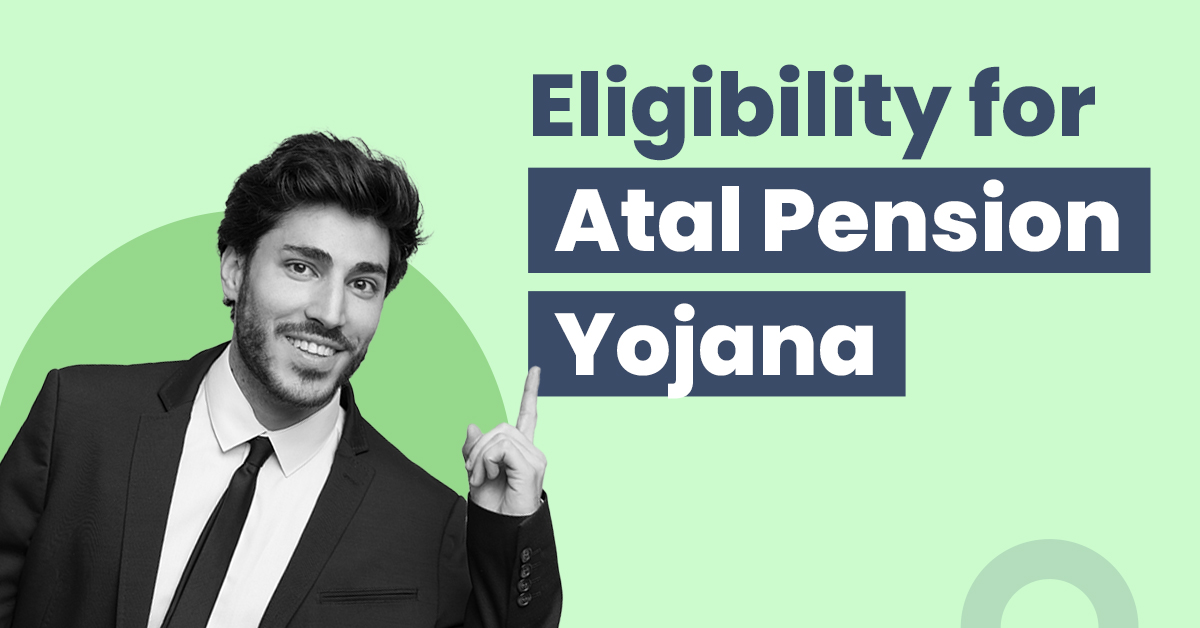What is the Eligibility for Atal Pension Yojana?


The Government of India is constantly working towards the betterment and welfare of the unorganised and underprivileged sector. With that objective in mind, the government introduced the Atal Pension Yojana in the 2015-16 annual budget. The pension scheme guarantees a retirement pension once you turn 60. The focus here is to bring workers in the age group of 18 to 40 years under the Atal Pension Yojana. Through this scheme, you can earn a pension ranging from Rs.1,000 to Rs.5,000 based on your monthly contribution. Your monthly contributions may differ based on the cover amount and the age at which you subscribe to the Atal Pension Yojana. The main focus of this article is to make you aware of the eligibility for Atal Pension Yojana, its key features and benefits.
What is the Eligibility for Atal Pension Yojana?
Let us look at the Atal Pension Yojana eligibility criteria in detail below:
- You should be an Indian citizen between the age group of 18 years to 40 years to be eligible for the Atal Pension Yojana. This implies that you are expected to contribute for a minimum of 20 years, after which you can start receiving a pension each month.
- Another important eligibility criterion for the Atal Pension Yojana is that your annual income should be below the taxable limit.
- You should have a KYC-compliant bank account. This eligibility criterion for the APY is to ensure and facilitate monthly contributions and maintain a minimum account balance to make such contributions.
- Your bank account and Aadhaar card must be linked.
- Another criterion for the Atal Pension Yojana eligibility requires that you should not be receiving benefits from any other government-backed social security program such as Employee Provident Fund.
- You should also not be subscribed to a company-backed scheme or other schemes that may give out a monthly pension after retirement.
- If you are an active subscriber of the Swavalamban Scheme or the NPS Lite, you pass the eligibility criteria for the Atal Pension Yojana if you are below the age of 40. All your previous contributions will be transferred to the Atal Pension Yojana, and your account will remain active.
- Please note that if you are a Swavalamban Scheme or the NPS Lite subscriber above the age of 40, you cannot migrate to the Atal Pension Yojana. You can either continue contributing to the old scheme until you are 60 or may choose to exit.
On August 10, 2021, the Department of Financial Services released an amendment regarding the Atal Pension Yojana criteria. The amendment states that if you are an income taxpayer, you will not be eligible to enjoy the benefits of the Atal Pension Yojana from October 1, 2022. The new rule states that taxpayers enrolled in the APY before October 1, 2022, will remain active. Any new subscriber joining on or after October 1, 2022, who is found to be an income taxpayer, will get a refund of the contributed amount, and their account will be closed.
What are the Features and Benefits of the Atal Pension Yojana
The following are the features and benefits of the Atal Pension Yojana:
- Regular Pension: Once you pass the eligibility criteria for Atal Pension Yojana and follow its rules, you will receive a regular pension after you turn 60. The range of the pension will be from a minimum of Rs.1,000 to a maximum of Rs. 5,000. Your monthly contribution to the scheme will determine your pension amount.
- Government Contribution: Initially, to attract more underprivileged people, the government announced that it would also contribute some amount up to the first five years. This opportunity was for individuals who subscribed to the scheme before March 31, 2016. The government would pay Rs. 1,000, or 50% of your total contribution, whichever is lower. However, as a new subscriber, you will not be able to enjoy this benefit.
- Default Charges: If you default on your monthly payments, the bank can charge you a penalty amount in the range of Rs. 1 to Rs. 10 per month basis the amount of contribution. The following is the table showcasing different penalty amounts.
| Monthly Penalty | Monthly Contribution |
| ₹ 1 | ₹ 100 |
| ₹ 2 | ₹ 101 to 500 |
| ₹ 5 | ₹ 501 to 1000 |
| ₹ 10 | ₹ 1,001 and above |
Payment Discontinuation: If you discontinue payments towards the Atal Pension Yojana, your bank has the right to:
- Freeze the account after six months
- Deactivate the account after 12 months
- Close your account after 24 months
Documents Required to Open APY Account
After learning about the eligibility criteria for Atal Pension Yojana, let us find out the documents you will need to open the account:
- Details of the bank and branch where you hold a savings account
- A duly filled Atal Pension Yojana registration form
- Your Aadhaar card for KYC compliance
- Your active mobile number (preferably linked to your bank account)
Final Thoughts
The Atal Pension Yojana is under the administration of the Pension Fund Regulatory and Development Authority (PFRDA). It is open to all citizens between the ages of 18 to 40. It is an ambitious initiative to provide a pension based on your monthly contributions. This scheme is particularly beneficial for people in the unorganised sector with low income and exposure to insurance. Through the Atal Pension Yojana, they can start building towards savings and earn a regular pension after turning 60.
FAQs
Can I apply for the Atal Pension Yojana online?
Yes, you can apply for APY online by using the Net banking facility provided by your bank.
Who is not eligible for the Atal Pension Yojana?
Any Indian citizen who has crossed the age of 40 or is a minor is not eligible for the Atal Pension Yojana. Also, according to the new amendment released by the Ministry of Financial Services, income taxpayers will not be eligible for the Atal Pension Yojana from October 1, 2022.
What if an APY subscriber dies?
In case the Atal Pension Yojana subscriber passes away, their spouse will receive the pension amount. And if both (the subscriber and spouse) are no longer alive, the accumulated corpus will go to the subscriber’s nominee.
Can husband and wife both take APY?
Yes. Both husband and wife can apply for the Atal Pension Yojana if they meet the eligibility criteria. Each of them will have an individual account and can choose different pension options.
What are the minimum and maximum ages to join APY?
The minimum age to subscribe to the Atal Pension Yojana is 18 years, whereas the maximum is 40 years. It means the scheme requires a minimum of 20 years of contributions before you start receiving a pension after the age of 60.



